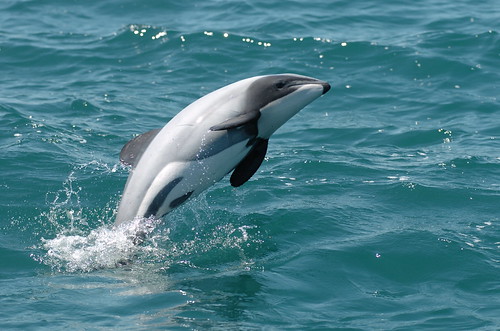目前地球上只剩下55隻成年毛伊海豚,被世界自然保育聯盟(IUCN)列為極度瀕危,是全世界最稀少且體型最小的海豚物種。牠們只生活在紐西蘭水域,存續狀況岌岌可危。
紐西蘭政府25日宣布新的毛伊海豚(Maui’s dolphins)保護政策,但紐西蘭綠黨認為,新政策並不足以保護毛伊海豚免於滅絕。
「我們最關心極度瀕危的毛伊海豚的處境。定置網是毛伊海豚最大的生存威脅。自2000年來,已經確認定置網導致2隻個體死亡,也是另外3隻的可能死因。」紐西蘭保育部長Nick Smith博士說。
國際捕鯨委員會2012年的科學委員會、IUCN和海洋哺乳動物學會的2000位科學家已經提出呼籲,在所有毛伊海豚出沒地點的100米等深線以內禁止刺網和拖網的使用。
毛伊海豚還有另一個生存威脅。接下來幾個月內,德州石油鉅子Anadarko將在塔拉納基和坎特伯雷的海底盆地進行探勘鑽油。
綠色和平組織紐西蘭分部委託進行的電腦模擬分析顯示,深海漏油可能摧毀紐西蘭美麗的海灘,影響所及可能遠至國際換日線。該組織已經請科學家們根據風向、潮汐和洋流等因素仔細評估漏油可能的影響範圍。
毛伊海豚是赫氏海豚在北島的亞種,被包括在紐西蘭政府新的威脅管理計畫之內。去年夏天進行的空中調查結果顯示赫氏海豚的數量約在6,300到13,100之間,相較於更早的冬季調查數據5,200和10,600之間略微成長。
國家黨政府並宣布將把9月實施的定置網臨時管制措施改為永久性,管制地區為塔拉納基海岸;並且在Pariokariwa Point和Waiwhakaiho河之間的海岸外2至7海浬處禁用定置網。初級產業部長Nathan Guy表示,初級產業部將提供每年$400,000的資金,供獨立觀察員監督新措施是否確實執行。「計畫也包括組成毛伊海豚研究諮詢小組,執行研究工作並和利害關係者協調合作確保毛伊海豚的生存。」Guy說。
不過綠黨並不因此認為新政策能保護海豚,「政府仍然允許在北島西岸的海洋哺乳動物保護區和海豚出沒的地區內使用致死的拖網和定置網。」Hughes說,「政府應該聽取科學界的共識,在毛伊海豚棲息地全面禁用刺網和拖網,直至一百米等深線處。我們無法承受再失去任何一隻毛伊海豚。」綠黨海洋事務發言人Gareth Hughes說,「國家黨政府在拿毛伊海豚的命運做賭注。新政策仍然允許在毛伊海豚棲息的海域內使用可能導致毛伊海豚死亡的捕魚方法。」
The New Zealand government Monday announced protections for Maui’s dolphins but the Green Party warned that these measures will not stop their slide into extinction. Just 55 adult Maui’s dolphins still exist. Found only in New Zealand waters and classed as Critically Endangered, the world’s smallest and rarest dolphin species is barely clinging to survival.
“The National Government is recklessly risking the extinction of the Maui’s dolphin,” said Green Party oceans spokesperson Gareth Hughes.“The government’s measures will still allow deadly fishing methods to be used in areas of Maui’s dolphin habitat.”
The National Government announced it will make permanent the interim set net protection measures put in place in September. The measures regulate fishing nets along the Taranaki coast, a stretch of the North Island’s west coast.
In addition, the government will ban the use of set nets from between two and seven nautical miles from the coast between Pariokariwa Point and the Waiwhakaiho River, also on the Taranaki coast.
“Our greatest concern is for the Critically Endangered Maui’s dolphin,” said Conservation Minister Dr. Nick Smith. “The greatest threat to the Maui’s dolphin is set-netting, with two confirmed and three likely deaths since 2000.”
Primary Industries Minister Nathan Guy said his ministry will fund $400,000 per year for the ongoing cost of independent observers to ensure these measures are obeyed.
“The plan also includes the establishment of a Maui’s dolphin Research Advisory Group to undertake research and work with stakeholders to maintain ongoing cooperation to ensure the survival of the Maui’s dolphin,” Guy said.
Maui’s dolphin is the North Island sub-species of the Hector’s dolphin, which is also covered by the government’s new Threat Management Plan.
The increase population estimates of Hector’s dolphins arises from an aerial survey last summer which recorded a population range of between 6,300 and 13,100. A winter survey found between 5,200 and 10,600 Hector’s dolphins.
But the Greens are not persuaded that the new measures will safeguard dolphins. “The government is still allowing the use of deadly trawl nets and set nets within parts of the West Coast North Island marine mammal sanctuary where dolphins could swim,” said Hughes.
“The government should listen to the scientific consensus that gillnet and trawl fisheries need to be closed in all areas where Maui’s dolphins live, out to the 100 metre depth contour,” he said. “We can’t afford to kill even one more Maui’s dolphin.”
The International Whaling Commission’s 2012 Scientific Committee, the International Union for the Conservation of Nature, and the Society for Marine Mammology, with its 2,000 scientists, have called for all areas where these dolphins are found to be closed to gillnets and trawl nets out to the 100 metre depth contour.
Another threat to the Maui’s dolphins comes as Texas oil giant Anadarko begins exploratory drilling in the Taranaki and Canterbury basins over the next few months.
A deep-sea oil spill could devastate some of New Zealand’s favorite beaches, with the effects stretching as far as the International Date Line, suggests new computer modeling commissioned by Greenpeace New Zealand.
Greenpeace NZ asked scientists to make detailed estimates of how far an oil slick could stretch based on wind, tide and sea currents.
※ 全文及圖片詳見:ENS





